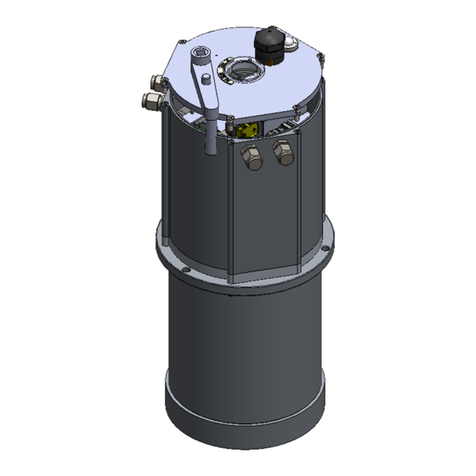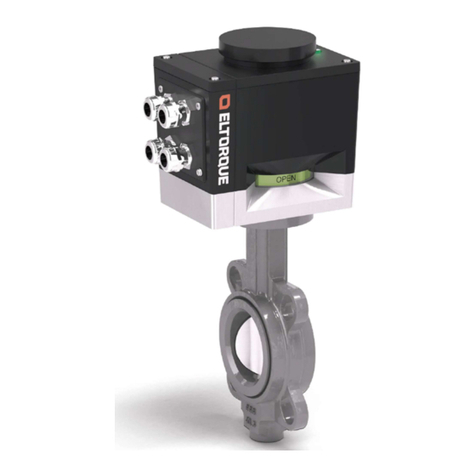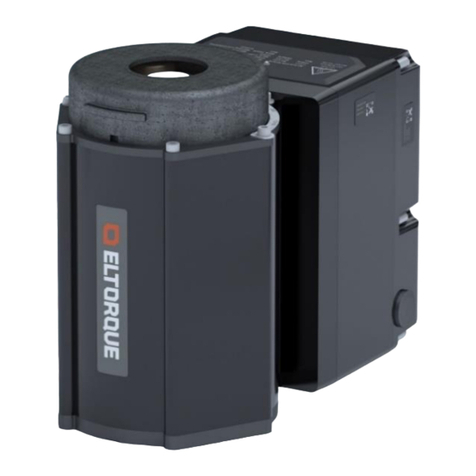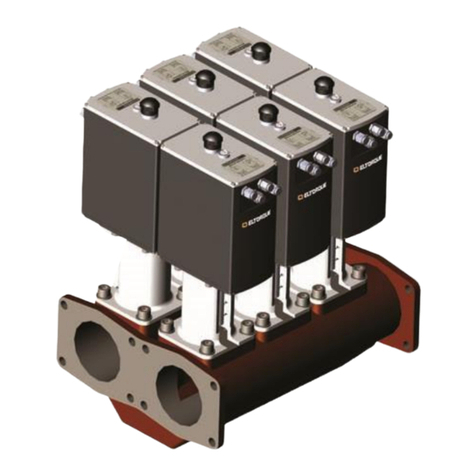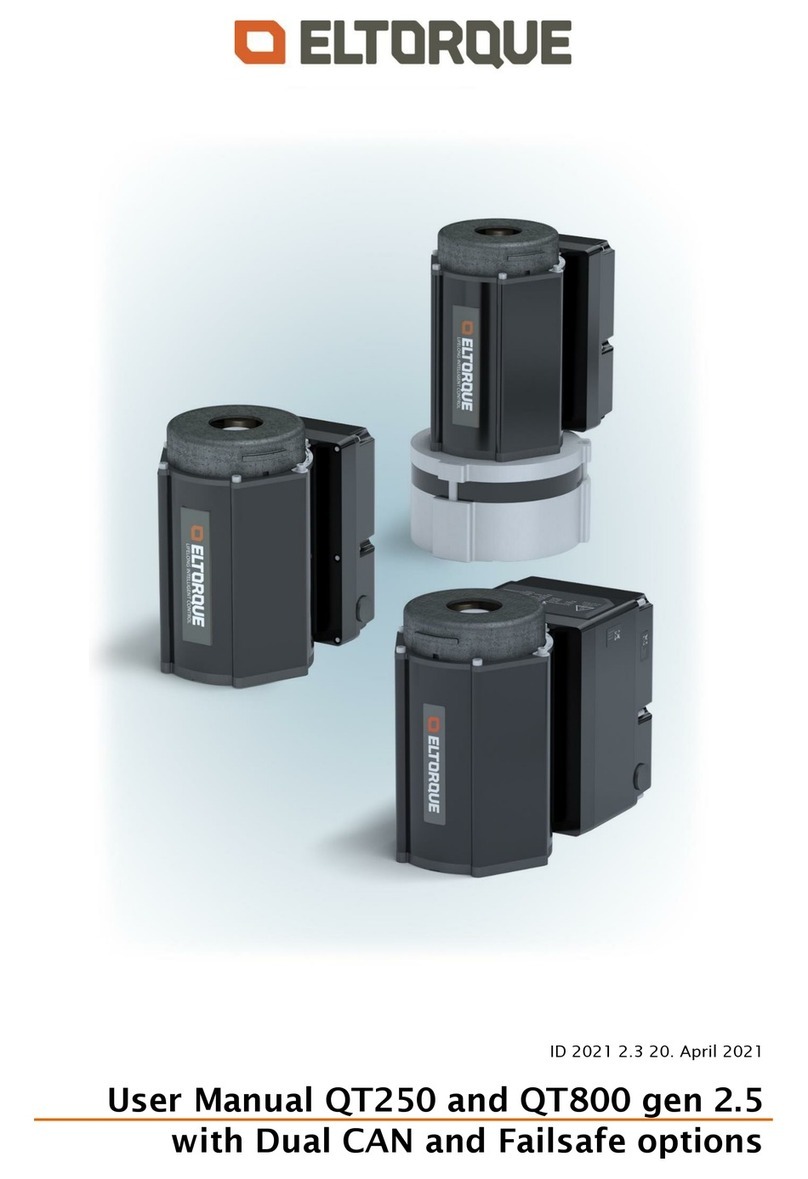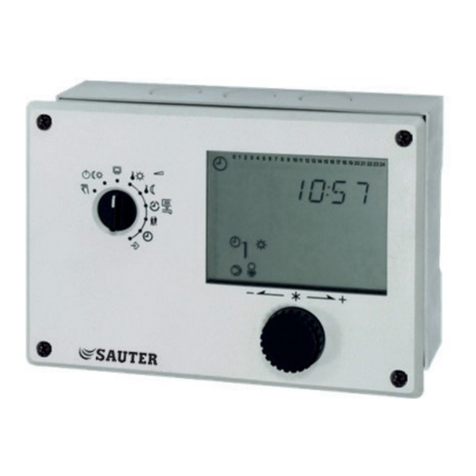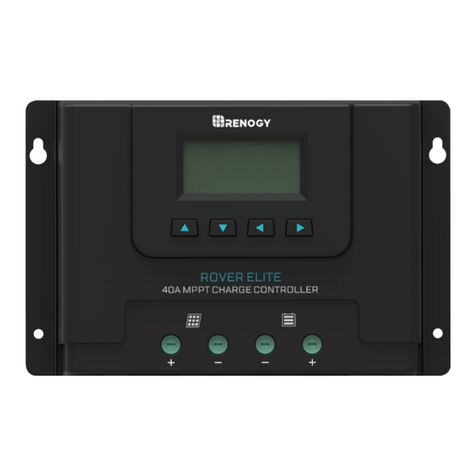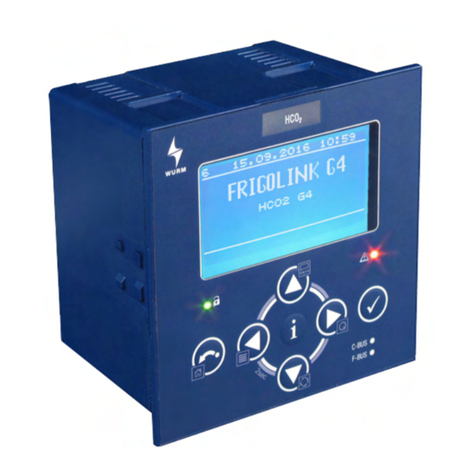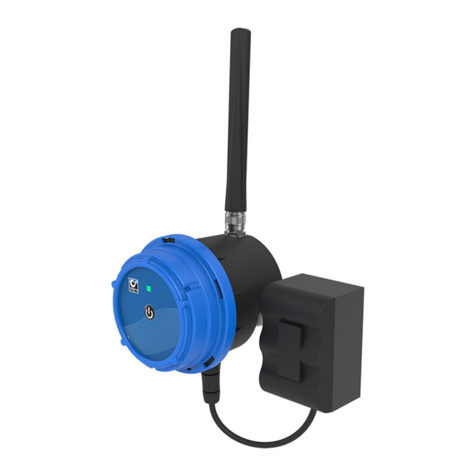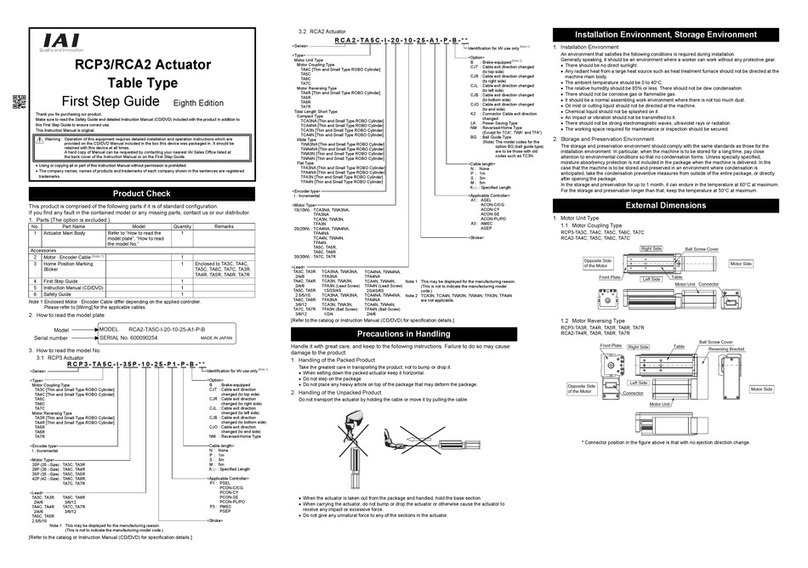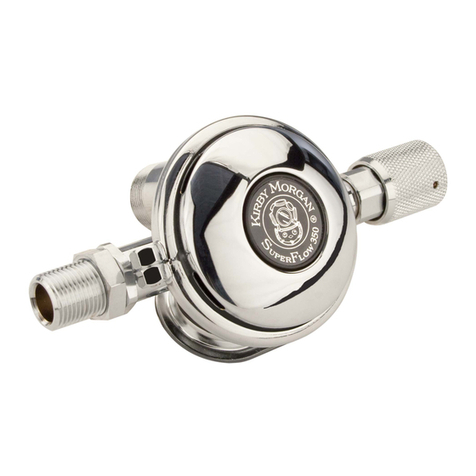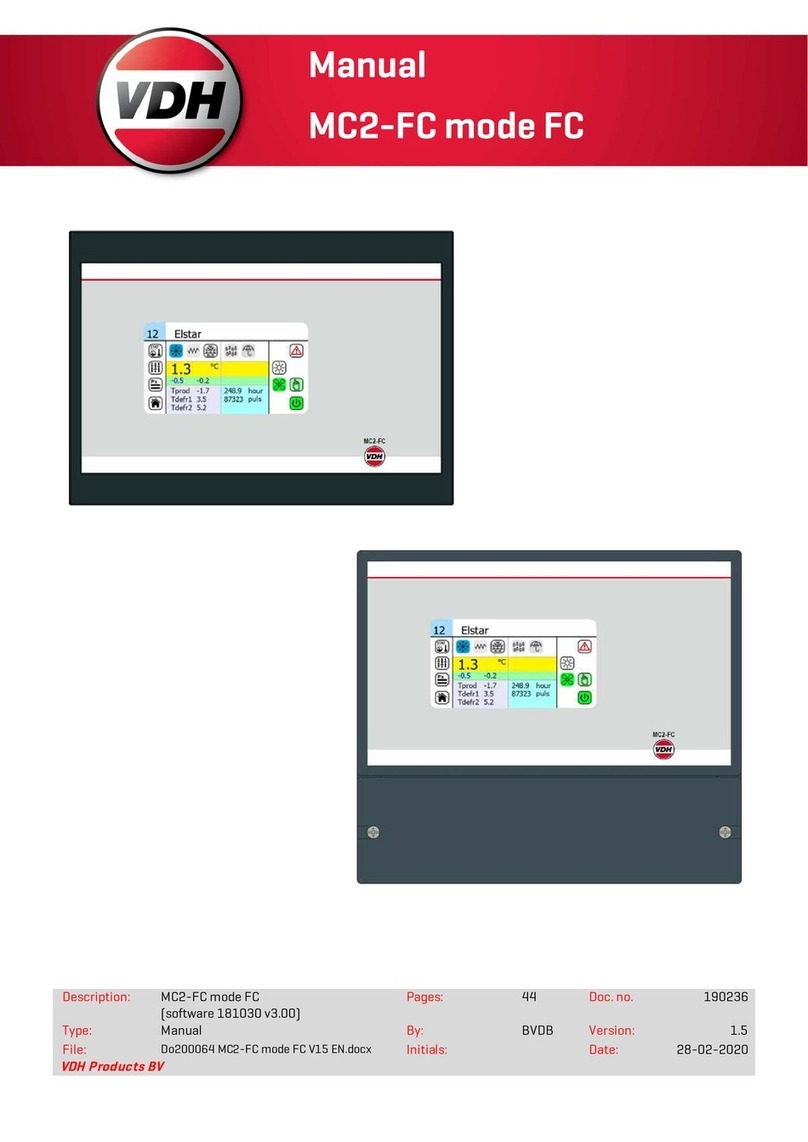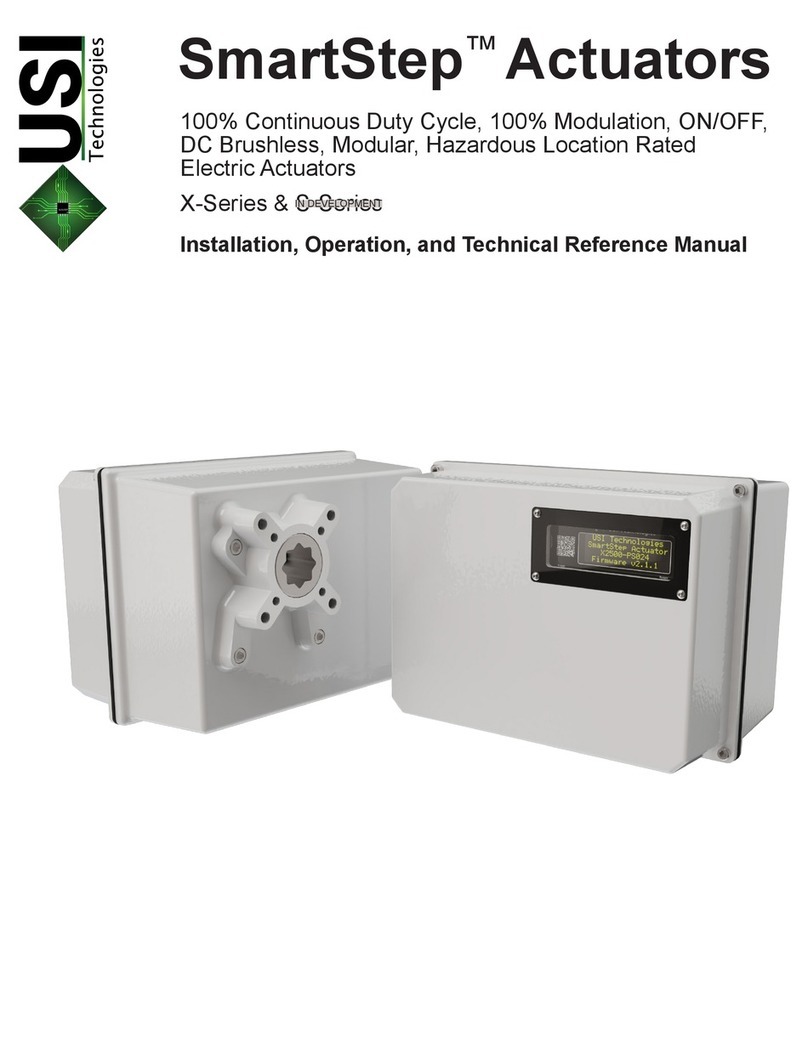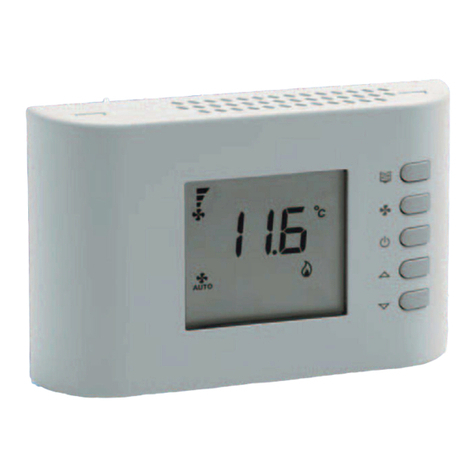Eltorque QT Series User manual

ID 2021 2.0 July 2018
User Manual QT250 and QT800
with Dual CAN and Failsafe options

Table 1: Document history for User Manual QT250 and QT800
Document
ID
Revision
Author
Changes
Approved
by
Date
2021
1.0
SKO
Based on 1372 with
adjustments.
Updated version
with Failsafe option
May 2018
2021
2.0
SKO
Added information
on Dual CAN
July 2018
Copyright © 2018, Eltorque AS
This document is submitted in confidence and contains proprietary information which shall not be
reproduced or transferred to others for the purpose, tender or any other intensions without written
permission of Eltorque AS

User Manual QT250 and QT800, ID 2021 2.0 July 2018
Page 3 of 86
Table of Contents
Chapter 1 Introduction ...............................................................................................................................................................7
1.1 System Overview ........................................................................................... 7
1.2 Description .................................................................................................... 8
1.3 Features ......................................................................................................... 9
1.4 Area of use .................................................................................................... 9
1.5 Technical support information .................................................................. 10
1.6 Reader groups ............................................................................................. 10
1.7 Notation used in this manual..................................................................... 10
1.8 Related documentation .............................................................................. 11
1.9 Disclaimer.................................................................................................... 11
1.10 Terms and abbreviations............................................................................ 11
1.11 About this user manual .............................................................................. 13
Chapter 2 HSE Information....................................................................................................................................................15
2.1 Care and cleaning of actuator.................................................................... 15
2.2 Disposal and waste handling ..................................................................... 15
Chapter 3 Product Description ...........................................................................................................................................17
3.1 QT250 and QT800 actuators ..................................................................... 17
3.2 Actuator control system examples ............................................................ 18
3.3 Technical specification ............................................................................... 19
3.4 Actuator components ................................................................................. 21
3.4.1 QT250 Actuator --------------------------------------------------------------------- 21
3.4.2 QT800 Actuator --------------------------------------------------------------------- 21
3.5 Communication interface box ................................................................... 22
3.6 Labelling ...................................................................................................... 22
3.7 Cabling......................................................................................................... 23
3.8 Storage......................................................................................................... 23
3.9 Engineering information............................................................................. 24
3.9.1 Power circuit design --------------------------------------------------------------- 24
3.9.2 Duty performance ------------------------------------------------------------------ 24
3.9.3 Endurance ------------------------------------------------------------------------------ 25
3.9.4 Shielding considerations -------------------------------------------------------- 25
3.9.5 Communication interface considerations ------------------------------- 25
3.9.6 Installations with Eltorque Hybrid Marine Cable --------------------- 27
3.9.7 Orientation----------------------------------------------------------------------------- 28
3.9.8 Space requirements---------------------------------------------------------------- 28
3.9.9 Mounting-------------------------------------------------------------------------------- 31
3.9.10 Additional information adaption actuator/valve --------------------- 31
3.9.11 Torque considerations for valve and actuator------------------------- 31
3.9.12 Closing time--------------------------------------------------------------------------- 31
3.9.13 Configuration ------------------------------------------------------------------------- 32
Chapter 4 Mounting and Installation..............................................................................................................................33
4.1 Mounting the actuator on the valve .......................................................... 33
4.2 Mounting procedure QT250 and QT800................................................... 33
4.3 Valve flange fastening holes ...................................................................... 34
4.4 Cable connection overview......................................................................... 35

Table of Contents
Page 4 of 86
User Manual QT250 and QT800, ID 2021 2.0 July 2018
4.5 Cable glands................................................................................................ 36
4.6 Power supply connection............................................................................ 37
4.7 Grounding (earthing) .................................................................................. 39
4.8 Communication connection interfaces...................................................... 39
4.8.1 Connection procedure ------------------------------------------------------------ 39
4.8.2 CANopen interface connection ----------------------------------------------- 39
4.8.3 Digital interface connection --------------------------------------------------- 41
4.8.4 Analog interface connections ------------------------------------------------- 42
Chapter 5 Operation..................................................................................................................................................................43
5.1 Manual operation ........................................................................................ 43
5.2 Error alarms and error handling ................................................................ 44
5.2.1 GENERAL alarm ---------------------------------------------------------------------- 44
5.2.2 POSITION UNDEFINED alarm --------------------------------------------------- 44
5.2.3 TEMPERATURE alarm -------------------------------------------------------------- 45
5.2.4 TORQUE alarm------------------------------------------------------------------------ 45
5.3 Troubleshooting.......................................................................................... 46
Chapter 6 Maintenance............................................................................................................................................................49
6.1 Maintenance overview ................................................................................ 49
6.2 Inspection .................................................................................................... 49
6.3 Tightening of bolts ..................................................................................... 49
6.4 Lubrication................................................................................................... 49
6.5 Care and cleaning of anodizing ................................................................. 49
Chapter 7 Technical Details..................................................................................................................................................51
7.1 Surface treatment ....................................................................................... 51
7.2 Communication interface ........................................................................... 51
7.2.1 CANopen interface ----------------------------------------------------------------- 51
7.2.2 Digital interface---------------------------------------------------------------------- 51
7.2.3 Analog interface --------------------------------------------------------------------- 53
Chapter 8 Ordering Information and Recommended Spare Parts ................................................................55
Dual CAN Option..................................................................................................................................................59
A.1Terms and abbreviations............................................................................ 59
A.2 Product description..................................................................................... 59
A.2.i. Differences from standard to Dual CAN actuator-------------------- 60
A.3 Actuator control system examples ............................................................ 60
A.4 Engineering information............................................................................. 61
A.4.i. Cabling considerations----------------------------------------------------------- 61
A.5 Mounting and installation .......................................................................... 61
A.6 Operation..................................................................................................... 62
A.7 Ordering information.................................................................................. 62
A.8 Technical details ......................................................................................... 63
A.8.i. Dual CAN ------------------------------------------------------------------------------- 63
Failsafe Option......................................................................................................................................................65
B.1Terms and abbreviations............................................................................ 66
B.2 Disposal and waste handling ..................................................................... 66
B.3 Product Description .................................................................................... 66
B.3.i. Differences from standard to failsafe actuator ----------------------- 67
B.3.ii. Failsafe actuator components------------------------------------------------- 67
B.4 Planning ....................................................................................................... 68
B.4.i. Installation plan --------------------------------------------------------------------- 68

Table of Contents
User Manual QT250 and QT800, ID 2021 2.0 July 2018
Page 5 of 86
B.4.ii. Maintenance plan ------------------------------------------------------------------- 68
B.4.iii. Storage----------------------------------------------------------------------------------- 68
B.4.iv. Battery charge ------------------------------------------------------------------------ 69
B.4.v. Space requirements---------------------------------------------------------------- 69
B.5 System interface.......................................................................................... 71
B.6 Mounting and installation .......................................................................... 71
B.6.i. Opening the actuator to access connectors ---------------------------- 72
B.7 Operation..................................................................................................... 72
B.7.i. Operation of the hand-wheel -------------------------------------------------- 72
B.7.ii. Actuator states----------------------------------------------------------------------- 72
B.7.iii. LED indication ------------------------------------------------------------------------ 73
B.7.iv. Troubleshooting overview ------------------------------------------------------ 74
B.8 Maintenance ................................................................................................ 74
B.8.i. Battery discharge and charge ------------------------------------------------- 74
B.8.ii. Changing battery on the UPS unit------------------------------------------- 75
B.9 Ordering information.................................................................................. 79
Torque and Screw Recommendations ....................................................................................................81
C.1 Eltorque torque recommendations............................................................ 81
C.2 Mounting screws and lubrication .............................................................. 81
C.3 M4 screws on communication interface box ............................................ 82
Earthing Methods in Maritime Installations .......................................................................................83

Table of Contents
Page 6 of 86
User Manual QT250 and QT800, ID 2021 2.0 July 2018
This page is left intentionally blank

User Manual QT250 and QT800, ID 2021 2.0 July 2018
Page 7 of 86
The Eltorque Lifelong Intelligent control concept provides maintenance-free,
configurable eco-friendly and fully electric actuators with real-time feedback.
The Eltorque actuators are divided in two main families:
•QT-series of actuators are ideal for quarter-turn valves such as butterfly and
ball-valves.
•MT-series of actuators are multi-turn actuators optimized for linear valves
such as globe valves, and with a form factor that make the MT-series ideal for
manifold actuation.
The Eltorque actuators are fully electric and can be connected in series. They
offer a plug and play solution with low installation costs and high level of
security. By combining the Eltorque actuators with the Eltorque Hybrid Marine
Cable, the cost of installation is even further reduced.
The Electric bus connected actuator installation eliminates the cable clutter,
transportation loss, air or oil leakage associated with conventional actuator
The use of permanent magnet-based motor technology and efficient electric,
mechanics and firmware design guarantee an eco-friendly and cost-efficient
ownership.
Eltorque actuators have a proven track record of lifelong maintenance-free
operation with 15 years of proven operation.
Figure 1: System overview example

Introduction
Page 8 of 86
User Manual QT250 and QT800, ID 2021 2.0 July 2018
The QT250 and QT800 described in this manual are part of the QT series. This
series is characterized by their quarter-turn movement and low energy
consumption along with their small footprint. They are suited for butterfly, ball
and other quarter-turn valves.
The QT250 and QT800 actuators are available in different versions with
corresponding User Manuals:
Table 2: Product overview
A= Plain actuator, B= with Failsafe option, R1= with Dual CAN, R2= with Failsafe
and Dual CAN, H= Actuator with cable glands for Eltorque Hybrid Marine Cable.
Product
Product id
User Manual
QT250 2.5 CANopen Actuator
250.120.5A and 250.120.5AH
Doc ID 2021
QT250 2.5 Digital/Analog Actuator
250.150.5A
QT800 2.5 CANopen Actuator
800.120.5A and 800.120.5AH
QT800 2.5 Digital/Analog Actuator
800.150.5A
QT250 2.5 CANopen Failsafe Actuator
250.120.5B and 250.120.5BH
QT800 2.5 CANopen Failsafe Actuator
800.120.5B and 800.120.5BH
QT250 2.5 Dual CAN Actuator
250.120.5R1 and 250.120.5R1H
QT800 2.5 Dual CAN Actuator
800.120.5R1 and 800.120.5R1H
QT250 2.5 Dual CAN and Failsafe
Actuator
250.120.5R2 and 250.120.5R2H
QT800 2.5 Dual CAN and Failsafe
Actuator
800.120.5R2 and 800.120.5R2H
QT250 1.0 CANopen Actuator
250.120.1and 250.120.1H
Doc ID 1372
QT250 1.0 Digital Actuator
250.110.1
QT250 1.0 Analog Actuator
250.130.1,
QT250 1.0 Modbus Actuator
250.140.1 and 250.140.1H
QT800 1.0 CANopen Actuator
800.120.1and 800.120.1H
QT8001.0 Digital Actuator
800.110.1
QT800 1.0 Analog Actuator
800.130.1
QT800 1.0 Modbus Actuator
800.140.1and 800.140.1H
QT250 1.0 CANopen Actuator - Open
Deck
250.121.1 and 250.121.1H
QT250 1.0 Digital Actuator- Open Deck
250.111.1
QT250 1.0 Analog Actuator- Open Deck
250.131.1
QT250 1.0 Modbus Actuator- Open
Deck
250.141.1 and 250.141.1H
QT800 1.0 CANopen Actuator- Open
Deck
800.121.1 and 800.121.1H

Introduction
User Manual QT250 and QT800, ID 2021 2.0 July 2018
Page 9 of 86
Product
Product id
User Manual
QT800 1.0 Digital Actuator- Open Deck
800.111.1
QT800 1.0 Analog Actuator- Open Deck
800.131.1
QT800 1.0 Modbus Actuator- Open
Deck
800.141.1 and 800.141.1H
QT250 CANopen 2.4 EX Actuator
EX250.125.4 and EX250.125.4H
Doc id 1193
QT800 CANopen 2.4 EX Actuator
EX800.125.4 and EX800125.4H
This User Manual describes the standard 2.5 version with the options for Dual
CAN and Failsafe.
The Eltorque actuators provides a wide range of attractive features:
•Optimized single-axis architecture, ensuring a compact and low-weight
actuator.
•Accurate real-time magnetic position control with no mechanical limit
switches, ensuring maintenance-free operation.
•Few spare parts - low lifetime costs.
•Easy setup and commissioning –low installation cost.
•Specific alarms including over-torque and temperature –providing high
operation safety.
•Robust implementation of CANbus protocol ensuring a reliable bus
connection.
•Reduced power consumption that gives a greener profile.
•Self-lock feature which allows movements from the motor, but immediately
locks movements from the valve side.
•Fast and precise motor that reduces the closing time.
•Low start-up load which enables a high number of actuators per power fuse.
•Remote programming via the CAN bus protocol on the Hybrid Marine Cable.
•Specific alarms including over-torque and temperature –providing high
operation safety.
•Option for Dual CAN see Appendix A on page 59.
•Option for Failsafe operation see 0 on page 64
Eltorque actuators are an ideal choice in a wide range of Maritime and Onshore
systems such as:
•Cargo handling
•Bilge and ballast

Introduction
Page 10 of 86
User Manual QT250 and QT800, ID 2021 2.0 July 2018
•Tank gauging
•SPS system
•Anti-heeling systems
•RSW systems
•Bulk handling
•Fuel systems
•Hydro power and district heating
•Waste water treatment
•HVAC system
•Fire water system
•Oil Production system, oil transfer line
If you require technical support outside of this manual, we recommend that you
use the support functions available on the web-site or contact us via e-mail.
If you have feedback to this manual, that should also be routed through e-mail.
Eltorque AS
Julianus Holms veg 34
7071 Trondheim
Norway
Web: www.eltorque.no
e-mail: info@eltorque.no
Phone: +47 74 85 55 20
Fax: +47 74 85 55 12
The following reader groups have been defined for this User Manual:
•Project and engineering personnel
•Installation personnel
•Operators
•Supervisors
•Technical support personnel
•Technical management personnel
The following notations have been used in this manual:
Bold is used for commands and menu selection.
Italic is used to give emphasis to information. It is also used for names of
documents referred to in the manual.
Note! Note is used to draw attention to important or helpful information
Caution! A caution is used when there is a danger that the equipment is damaged
if you do not follow the instructions.

Introduction
User Manual QT250 and QT800, ID 2021 2.0 July 2018
Page 11 of 86
Warning is used to draw attention to information of very high importance,
for example to avoid injuries to personnel.
This User Manual QT250 and QT8001is related to the following documentation:
Table 3: Related documentation
Document
Document ID
Hybrid Marine Cable product datasheet
Eltorque document ID 1946
Eltorque E3C Manual
Eltorque document ID 1687
Guidelines for earthing in maritime
installations
Published by the Norwegian Electrical
Safety Directorate. Available on net or
supplied by Eltorque on request.
System Integrators Manual CANopen
Interface
Eltorque document ID 1691
User Manual
QT250 2.4 EX
QT800 2.4 EX
Eltorque document ID 1193
User Manual QT250 and QT800 1
Eltorque document ID 1372
Note! 1 See Table 2: Product overview on page 8 for specification of the relevant User
Manuals for the QT250/QT800 series.
The information contained in this document is subject to change without prior
notice. Eltorque AS shall not be liable for errors contained herein or for incidental
or consequential damages about the furnishing, performance, or use of this
document. It is the customer’s responsibility to verify that he has the latest
revision available by checking the document area of www.eltorque.no
Table 4: Terms and abbreviations
Term
Description
ABS
American Bureau of Shipping.
AFD
Asbestos Free Declaration.
Analog Control
Step-less control utilizing analog signals, e.g. 4-20 mA. Allows positioning of the
valve actuator between Open and Closed.
BTO
Break to open. The torque required to unseat the closed valve.

Introduction
Page 12 of 86
User Manual QT250 and QT800, ID 2021 2.0 July 2018
Term
Description
CAN/CAN bus
Controller Area Network.
CAN bus is a fieldbus which allows communication between a maximum of 127
actuators connected to the same network. It is not a “master-slave” network (ref.
Modbus), hence all the nodes in the network can actively send messages at their
own initiative. Communication is prioritized meaning that urgent messages are
transmitted and received before information with lower priority. Compared to
Modbus, CAN bus has quite a few advantages:
−More reliable communication
−More nodes per network
−More control and configuration features are available
−Higher performance
CANopen
CANopen is a higher-level protocol and is running on top of the CAN protocol for
all Eltorque actuators.
The standard consists of an addressing scheme for the nodes on the CAN bus
and several small protocols for communicating with each node. In terms of the
OSI model, CANopen implements the levels above, including the network layer.
CCS
Central Control System.
Communication
Interface Box
Electronic device controlling the actuator according to signals from an overall
control system such as a PLC or other type of electronic controller.
Configuration
The set-up of parameters, which affects the actuator’s performance and
behavior.
Digital Control
Simple control utilizing relays, on/ off switches and indicators. Allows only Open
or Closed functionality for a valve actuator.
DNV GL
Det Norske Veritas Germanischer Lloyd.
E3C
Eltorque Common Configuration Controller.
E-VCI
Eltorque Valve Control Interface
E-VCS
Eltorque Valve Control System offers a dedicated control system
for operation of Eltorque actuators.
Eltorque Valve Control System is suitable for installations where the operator
requires full control of all valves and pumps, and in addition monitor level,
temperature, flow and pressure.
Hazardous area
Area in which the permanent or periodical presence of explosive substances
causes a risk of explosion.
Products described in this manual are not suitable for use in hazardous areas.
Eltorque can deliver actuators for use in such areas if required. Please contact
your local representative for further details.
HMI
Human Machine Interface.
HSE
Health, Safety and Environment.
HVAC
Heath, ventilation and air condition
IACS
International Association of Classification Societies
IAS
Integrated Automation System.
ICS
Integrated Control System.
IMO
International Maritime Organization
LR
Lloyd’s Register.
MAST
Maximum allowable stem torque/thrust.
MD
Material Declaration.
MEPC
The Marine Environment Protection Committee

Introduction
User Manual QT250 and QT800, ID 2021 2.0 July 2018
Page 13 of 86
Term
Description
OSI model
Open Systems Interconnection model. The model is a conceptual model that
standardizes communication systems without regard to the underlying internal
structure. The model partitions a communication system into abstraction layers.
Out of range
Definition of position. The outgoing shaft is outside the defined position area.
PF
Power factor
PCB
Printed circuit board.
PLC
A Programmable Logic Controller is a digital computer used for automation of
industrial processes, such as control of machinery on factory assembly lines,
measurement and control of process plants etc.
RSW
Refridgerated sea water system
SDoC
Supplier Declaration of Conformity.
SOLAS
Safety Of Life At Sea –conversion under IMO concerning safety for personnel and ships at
sea.
SPC
Statistical process control
VA
Voltampere
UPS
Uninterruptable power supply.
Valve
A valve is a device that controls the flow of materials (gases, fluidized solids,
slurries, or liquids) by opening, closing, or partially obstructing various
passageways.
Actuator
A device for control of valves in various process control systems.
Valve top
flange
The flange on top of the valve which integrates the actuator. Key parameters to
be aware of are summarized in 3.3 Technical specification on page 19. As an
example, butterfly valves typically comprise four screw holes for the flange
integration and a square stem for valve operation.
Within range
Definition of position. The outgoing shaft is within the defined position area.
This user manual describes the guidelines for installation, setup and operation of
QT250 and QT800 in a valve control system. The valid products for this manual
are listed in Table 2: Product overview on page 8.
Chapter 1 introduces the product and this manual.
This chapter is intended for all reader groups.
Chapter 2 informs on health, safety and environment issues.
The reader group for this chapter is for supervisors, technical support and
technical management personnel.
Chapter 3 gives a product description including the mechanical construction of
the actuator, technical specifications and a functional description. There is also
an overview of technical issues that should be considered in the design and
planning phase for the installation.
The reader group for this chapter is supervisors, project and planning personnel.

Introduction
Page 14 of 86
User Manual QT250 and QT800, ID 2021 2.0 July 2018
Chapter 4 covers the mechanical installation on valves and the electrical
installation of power and control signal.
The reader group for this chapter is installation personnel.
Chapter 5 covers the use of the actuator such as how to use the manual
emergency operation. There is also an overview of error messages and a
troubleshooting overview.
The reader group for this chapter is operators.
Chapter 6 covers maintenance, inspection and repair of the actuator.
The reader group for this chapter is operators, technical support and
management personnel.
Chapter 7 gives more in-depth technical information on the product.
The reader group for this chapter is technical support and management
personnel.
Chapter 8 gives ordering information.
The reader group for this chapter is technical support and management
personnel.
Appendix A describes the Dual CAN option, how to install and operate an
actuator with this option. The reader group for this chapter is installation
personnel, operators, support personnel and management personnel.
Appendix B describes the Failsafe option, how to install and operate an actuator
with this option. The reader group for this chapter is installation personnel,
operators, support personnel and management personnel.
Appendix C gives an overview of torque recommendations for actuator bolts.
The reader group for this chapter is installation personnel.
Appendix D includes the document “Earthing Methodology in Maritime
Installations” The reader group for this chapter is installation personnel,
technical support and technical management personnel.

User Manual QT250 and QT800, ID 2021 2.0 July 2018
Page 15 of 86
This chapter includes safety information that the user needs to know to operate
the equipment without doing harm to personnel or the environment.
The operation of the equipment is safe provided that the recommended
operating procedures are followed. There are specific hazards however
that need to be addressed so that the user knows how to deal with them.
Electrical installations shall be designed and installed by personnel with
certifications according to applicable laws and regulations. Ensure that all
such work is done according to applicable laws and regulations.
Service must always be performed by trained personnel.
All batteries and electronic equipment may contain substances harmful to the
environment. After removing used equipment, return them for disposal
according to local governmental guidelines.
Caution! Do not use ammonia, alkaline cleaners, lye or strong acid for cleaning as
this can damage the protective anodized layer of the product surface.
Caution! Do not use high pressure power washer directly on the actuators as the
product is not IP69K rated.

HSE Information
Page 16 of 86
User Manual QT250 and QT800, ID 2021 2.0 July 2018
This page is left intentionally blank

User Manual QT250 and QT800, ID 2021 2.0 July 2018
Page 17 of 86
The QT250 and QT800 are the most sold products in the Eltorque portfolio. They
have been used on a various of vessel types on butterfly and ball valves. The
QT800 is based on the QT250, with an additional gearbox to further increase the
output torque. They are equipped with a magnetic position sensor that gives a
correct position feedback, even after a power outage. Both can be manually
operated by the means of a fixed hand wheel located under the cover on top of
the actuator without the need for external tools. Both QT250 and QT800 can be
delivered with the Failsafe option described in 0 on page 64 and the CAN Dual
option described in Appendix A on page 59.
The QT250 actuator is suitable for valves with torque requirements between 100-
250 Nm, while the QT800 is suitable for 320-800 Nm. Both can be delivered with
CANopen, Analog and Digital communication.
Note! For actuators equipped with Failsafe and/or Dual CAN options, these are only
available with the CANopen communication interface.
The actuators are designed to be operational during a temporary submerged
situation, see details for housing in Table 5: System performance parameters for
QT250 and QT800 actuators on page 19.
Figure 2: Actuator mounted on a valve
Caution! Remember to have the actuator checked by Eltorque after all submerged
situations to keep the warranty.

Product Description
Page 18 of 86
User Manual QT250 and QT800, ID 2021 2.0 July 2018
The actuator must be integrated with the main control system in one of two
ways:
•Directly to the main control system. In this case it is important to consider
the communication protocol.
•Through a stand-alone sub-system delivered by Eltorque. This is a
standardized hardware and software platform tailored for Eltorque actuators.
The solutions illustrated below show a bus connection with the Eltorque Hybrid
Marine Cable. This cable can be used with the CANopen and Dual CAN
communication interface. In addition, Eltorque actuators support Digital and
Analog connections.
Figure 3 below shows Eltorque actuators that are connected to a cabinet with
Eltorque valve control system (E-VCS). In this example, pump starters are also
connected to the E-VCS. Other equipment, such as sensors can also be connected
to the E-VCS. The E-VCS includes an HMI interface on the cabinet and can also
support an HMI interface on main control level.
Figure 3: Eltorque Valve Control System (E-VCS) with valve and pump control
Figure 4 below shows Eltorque actuators that are connected directly to a
customer specific PLC, PC or other control unit. In addition, Eltorque actuators
support digital and analog connections. On system level, the PLC, PC or
Controller must be compliant with Eltorque communication protocol according to
Eltorque System Integrators Manual.

Product Description
User Manual QT250 and QT800, ID 2021 2.0 July 2018
Page 19 of 86
Figure 4: Eltorque actuator loop connected to Integrated Automation Control System (IAS
or ICS)
Table 5: System performance parameters for QT250 and QT800 actuators
QT250
QT800
Valve flange and max
allowed rated torque
options
100, 150 or 250 Nm
320, 480 or 800 Nm
Closing time options
0-90movement:
12, 15, or 20 seconds
0-90movement:
42, 52.5 or 70 seconds
Valve spindle adaptor
SQ17
depth 38 mm/1.50 in
SQ27
depth 45 mm/1.77 in
Max. allowed valve
flange and related
torque
(Ref. ISO5211) 2001E
F05
F07
F10
F10
F12
125
250
500
500
1000
Valve applications
Quarter-turn
Examples:
Butterfly DN50-DN200 PN16
Floating Ball DN65-DN100 CL150
Quarter-turn
Example:
Butterfly DN150-DN200 CL150
Weight
11 kg/24.3 lb
20 kg/44.1 lb
Dimensions (HxWxD)
229 x 156 x 209 mm
9.02 x 6.14 x 8.23 in
333 x 200 x 239 mm
13.11 x 7.87 x 9.41 in
Manual operation –
number of turns
21 turns on hand wheel =
90movement on valve
73 turns on hand wheel =
90movement on valve
Color
Black
Housing
IP66 and IP x8 (10 m –100 hours/32 ft 9.7 in –100 hours).
Corrosion protected aluminum and steel enclosure.
Should not be exposed to corrosive chemicals.
Storage temperature
5 –35C/41 –95F

Product Description
Page 20 of 86
User Manual QT250 and QT800, ID 2021 2.0 July 2018
QT250
QT800
Operating temperature
With Failsafe option
-25 to 55C/-13 to 131F
0 to 45C/32 to 113F
Temperature protection
Motor current is switched off in case of over-heating.
Power supply
1-phase,110 –240V AC, 50/60 Hz, Max 240 VA
Power consumption
Opening and closing
with max torque1
100 VA, PF 0.79
Power consumption
Standby1
9 VA, PF 0.37
Duty performance
According to AN 15714-
1 / IEC 60034-1
Class A –10 cycles per hour/52 –15 min.
Endurance
According to EN 15712-
2
Classes A and B –10 000 cycles per lifetime.
Cable glands
Up to five M20 glands allows bus connection of power supply and
signal wiring. Use IP68 (10 m 72 hours) cable glands for all wires.
Communication
Interfaces options
CANopen allows positioning and other extended control of the
actuator. The absolute maximum theoretical number of devices allowed
on the bus is 127, but the actual number of nodes is limited by the
baud-rate and the cable quality. Eltorque recommends a maximum of
80 nodes on 500 m/1660ft cable.
Digital 2 DI (Open-Close) and 3 D0 (Open-Close-Alarm.)
Analog Al (Set position) A0 (Feedback position) and D0 (Alarm) (4-20
mA) AI/A0 signal.
Position sensor
Resolution: 360°/12bit = 0.35156°/bit
Integral Non-Linearity (INL): typ. ± 0.8°
Differential Non-Linearity (DNL): ± 0.176°
Output shaft accuracy: 1%
Position feedback not corrupted by power outage.
Configuration
USB connection to PC with Eltorque E3C. Special configuration cable is
needed, see E3C User Manual.
Configurable parameters
Open and Closed positions. Actuator speed, torque and valve position
regions. Inverted IO or bus parameters depending on the applied
communication interface.
Manual operation
Standard feature using fixed hand-wheel. Mechanical valve position
indicator. No need for external tools.
Cover of handwheel
Can be removed and refitted without tools. Protects mechanism against
mechanical damage and foreign objects. The actuator must not be
lifted by the top cover.
Self-lock
The QT250 and QT800 are equipped with a mechanical self-locking
device that locks the valve to the target position when the actuator
movement command is completed.
Certification/type
approval
All valid certificates are listed on www.eltorque.no –support –technical
support –certificates.
1 Earlier versions of the QT250 and QT800 have other values for power consumption, see Table 2:
Product overview on page 8 for information on the correct documentation to consult.
Other manuals for QT Series
1
This manual suits for next models
2
Table of contents
Other Eltorque Controllers manuals
Popular Controllers manuals by other brands
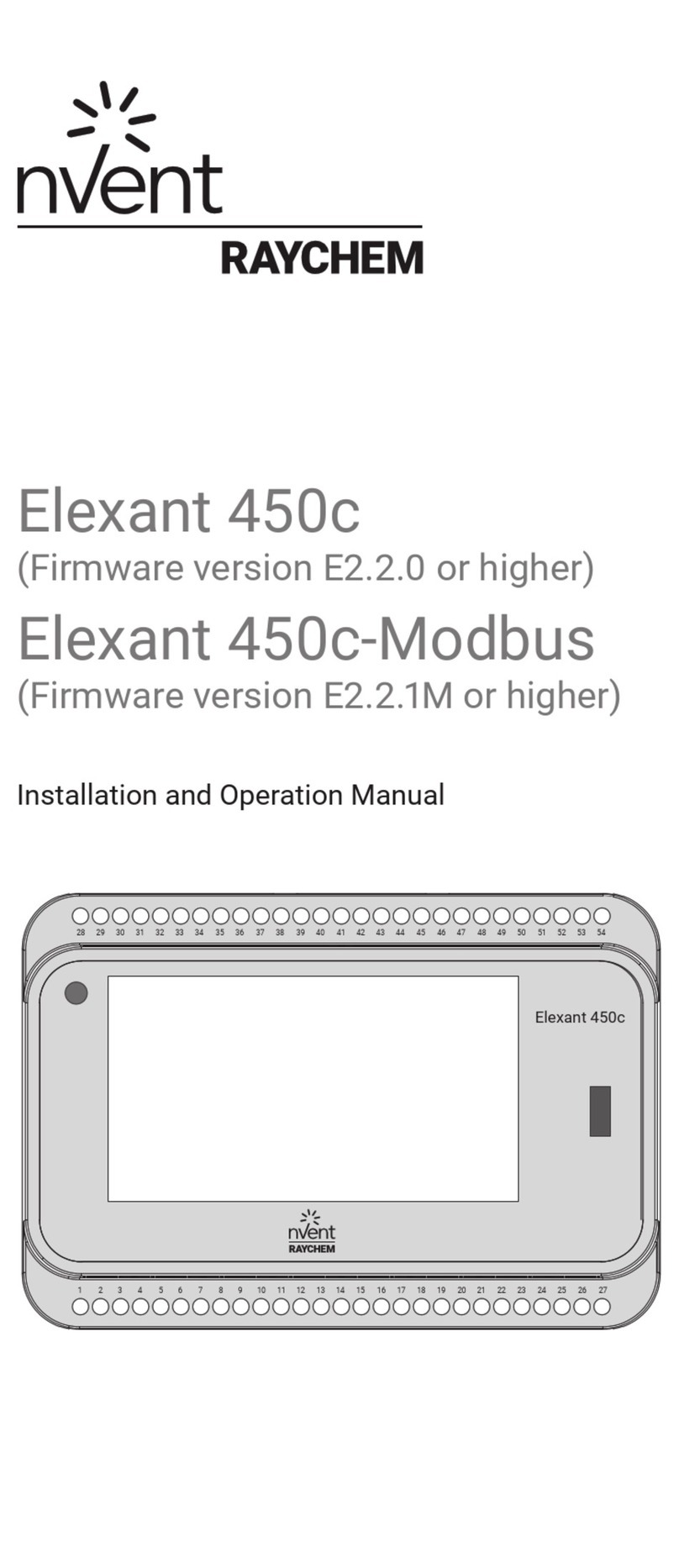
nVent RAYCHEM
nVent RAYCHEM Elexant 450c Installation and operation manual
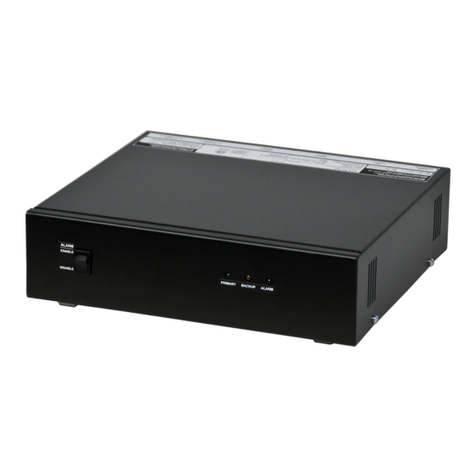
TSi Power
TSi Power ATS-500 Series installation instructions
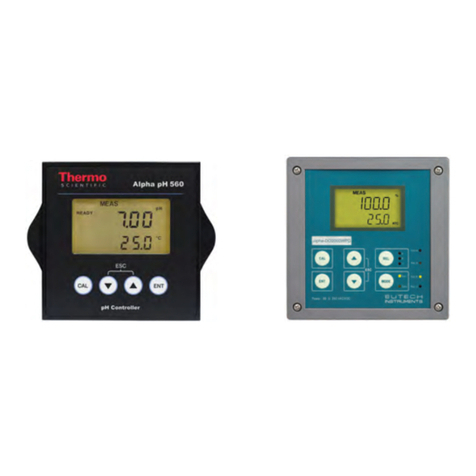
Thermo Scientific
Thermo Scientific ALPHA PH 560 manual
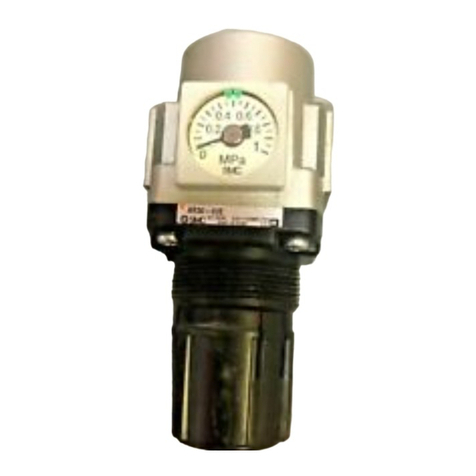
SMC Networks
SMC Networks AR20S 02E-Y 15V Series Operation manual
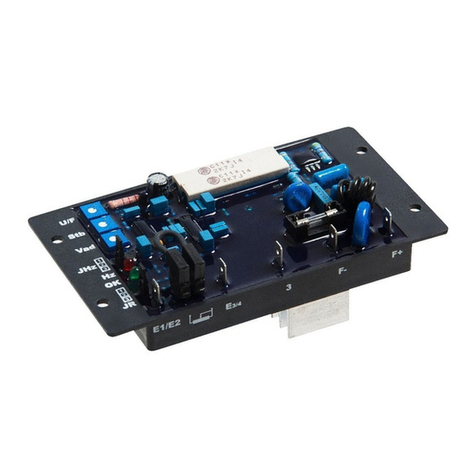
REACIONA
REACIONA AVR-A-OPT-03 18A Installation and operation manual
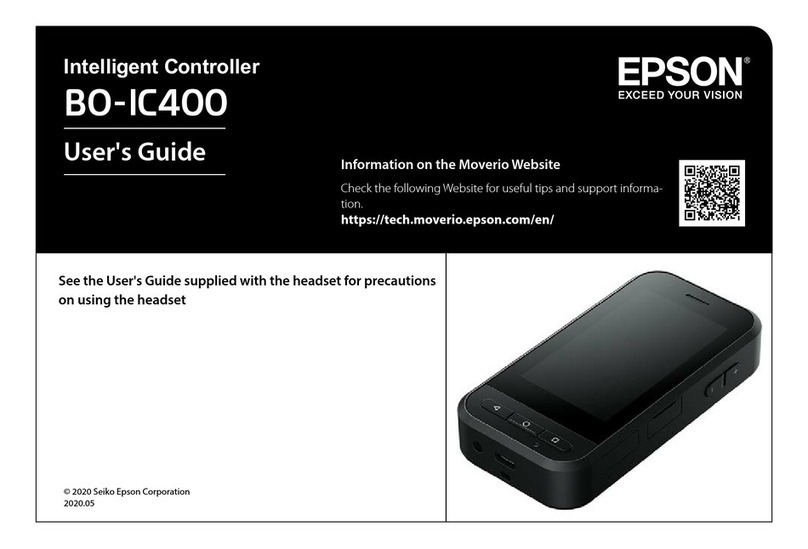
Epson
Epson BO-IC400 user guide
